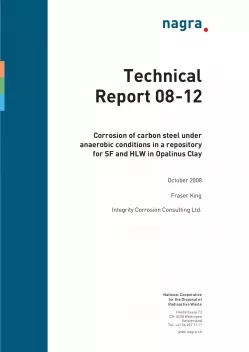
Technical Report NTB 08-12
Corrosion of carbon steel under anaerobic conditions in a repository for SF and HLW in Opalinus Clay
Nagra is considering carbon steel as one of the canister material options for the disposal of highlevel waste and spent fuel in a deep geological repository in Opalinus Clay. Following a brief period of aerobic conditions, the canister will be exposed to an anaerobic environment for much of its service life. Knowledge of the rate of anaerobic corrosion is important not only for estimating the canister lifetime but also for determining the rate of hydrogen generation.
This report describes a critical review of the anaerobic corrosion behaviour of carbon steel under environmental conditions similar to those expected in the repository. The aims of the report are:
- to recommend a (range of) long-term anaerobic corrosion rate(s) for carbon steel canisters, and
- to justify the use of this rate in safety assessments based on a mechanistic understanding of the structure and properties of the protective corrosion product films.
The review is based on selected studies from various national nuclear waste management programs, supplemented where appropriate with studies from other applications and with evidence from archaeological analogues.
The corrosion rate of carbon steel decreases with time because of the formation of a protective surface film. There are differences in behaviour in bulk solution and in the presence of compacted bentonite. In bulk solution, the corrosion rate decreases to an apparent steady-state rate after a period of approximately six months, with a long-term rate of the order of 0.1 μm⋅yr-1. The surface film comprises a duplex structure, with a magnetite outer layer and a spinel-type inner layer. In compacted clay systems the rate of decrease in corrosion rate is slower, with steadystate not being reached after several years of exposure. There is a significant body of evidence from apparently well-conducted experiments that indicate an anaerobic corrosion rate of the order of 1 – 2 μm⋅yr-1 in systems containing compacted clay and the protective films tend to be carbonate-based rather than magnetite-based.
There is no evidence in the literature that the use of a constant long-term corrosion rate for safety assessment purposes is not justified. Factors that are important in determining the structure and properties of the corrosion product film are reviewed, including the effects of the aerobicanaerobic transition on the film composition and structure, possible spalling of protective films, and the effect of the accumulation of corrosion products on the corrosion rate of the underlying steel.
